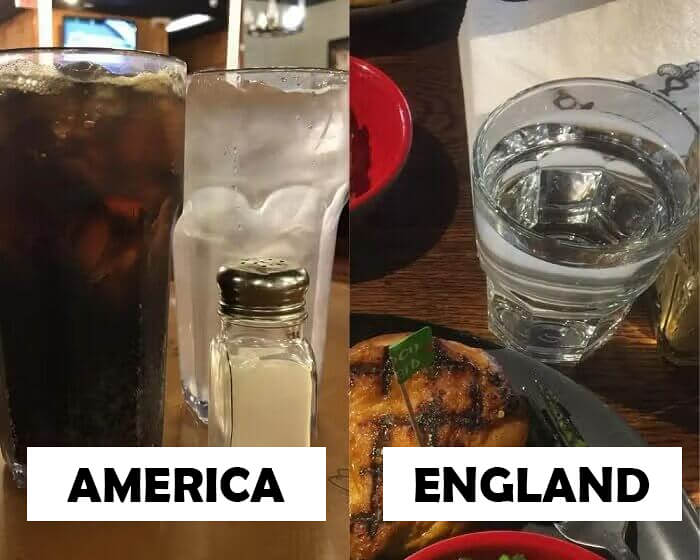Popular American Foods That Are Served Differently Everywhere Else

“Birthday Cake” Flavor Isn’t a Taste Sold in Other Countries
It seems that Americans are sometimes feeling a bit uninspired by their food options, leading to some quirky flavor choices. Take “birthday cake,” for example. This term doesn’t really signify a specific flavor in many parts of the world, which can be confusing. After all, why label a flavor after an event when cakes can come in so many delicious varieties?
In the U.S., though, “birthday cake” has become a popular flavor in its own right. It typically refers to a sweet vanilla flavor, often topped with frosting and colorful sprinkles. It’s a fun, nostalgic taste that many associate with celebrations, but it’s interesting how it’s taken on a life of its own.
This trend reflects how culinary creativity can sometimes lead to flavors that are more about the experience than the actual ingredients, creating a unique cultural phenomenon!

Bread Around the World
America isn’t often associated with healthy eating, and many people around the world might agree. In the U.S., white bread tends to be the most popular choice, despite its reputation for being low in nutritional value and often lacking flavor. It’s almost like a blank canvas, which some find unappealing.
In contrast, people in other countries tend to favor a variety of breads that are both healthier and more flavorful. Options like rye, sourdough, and pumpernickel not only offer more nutrients but also bring unique tastes and textures to the table. These breads often reflect local ingredients and traditions, making them a more interesting choice for many.
This difference highlights how cultural preferences can shape what we eat, showing that there’s a world of bread beyond the classic white loaf!

The French Don’t Quite Know What to Do With Canned Cheese
From a non-American perspective, the concept of cheese in a can can seem quite strange. Many people believe that cheese should come from quality dairy products and be crafted using traditional methods, not squeezed from a spray can. This is especially true in countries like France, where cheese-making is an art form, and there’s a strong pride in the quality and authenticity of their cheeses.
In contrast, canned cheese might be seen as convenient and affordable in the U.S., but it raises eyebrows elsewhere. It’s hard to compare it to real cheese made the traditional way; the textures and flavors are simply not the same. While canned cheese certainly has its place in casual snacking and quick meals, many would argue that it doesn’t hold a candle to the rich, complex flavors of artisanal cheese.
So, while “cheese in a can” exists and can be enjoyed for what it is, the question remains: is it truly cheese? For many, the answer lies in the craftsmanship and quality that goes into making real cheese.

Instagram/greenpocketprotector | Instagram/pistachewpb
Ice in Soft Drinks Is an American Thing
Ordering drinks in the U.S. can feel quite different compared to other places, especially in Europe. One big surprise for many is that refills are often free in the U.S., while in many European countries, you’ll typically be charged extra for additional drinks.
Another notable difference is the prevalence of ice in cold beverages. In the U.S., almost all cold drinks come with ice, making them refreshing, especially on a hot day. However, in many parts of the world, you usually have to request ice specifically; otherwise, your drink will be served without it.
In fact, in places like England, drinks are almost never served with ice, and water is typically at room temperature. This preference might be a cultural norm, with many people simply enjoying their beverages that way. These little differences highlight how varied drinking customs can be across the globe, making it an interesting aspect of travel and dining!

Instagram/daviddaleblack | Instagram/jurgisfitness
A Croissant Is Not Always Meant to Be a Sandwich
In the U.S., you’ll often come across croissants or croissant sandwiches, sometimes making it seem like the sandwich version is more common. If you’re an American who hasn’t traveled much, you might be surprised to learn that croissants are traditionally meant to be enjoyed on their own, rather than as a sandwich.
While croissant sandwiches are delicious and have gained popularity in many places, particularly for breakfast or brunch, most people in Europe still enjoy croissants as a pastry or dessert. They might pair it with coffee or enjoy it plain, savoring the flaky, buttery layers that make a croissant special.
This difference in how croissants are enjoyed showcases the variety in food culture and preferences around the world, reminding us that sometimes a classic treat is best appreciated in its original form!

Smarties Are a Bit Different Depending on the Country
For many Americans, the word “Smarties” instantly brings to mind those colorful, pebble-shaped sugar candies packed in a nostalgic long box. However, if you travel to Europe, the term means something quite different. There, Smarties refer to candy-covered chocolates, similar to M&M’s, which also come in a small box and boast bright colors.
Despite sharing the same name, these two treats are quite different in taste and texture. The American version is a sugary, chalky candy, while the European Smarties are chocolate-filled and coated in a candy shell. It’s a fascinating example of how the same name can refer to completely different products across cultures, highlighting the quirks of language and branding in the world of sweets!

Waffles in the US Versus Hong Kong
Waffles are a beloved breakfast staple in the U.S., and you can find a variety of sweet options wherever you go. Typically, American waffles are served with syrup, fresh fruit, or whipped cream, and sometimes even paired with savory meats for a delicious twist.
However, in Hong Kong, waffles take on a completely different form. Instead of the sweet, fluffy breakfast treat we’re used to, Hong Kong waffles resemble filled pitas. They have a pocket in the middle that can be stuffed with a wide range of ingredients, from sweet fillings like fruit and chocolate to savory options with meats and spicy sauces.
This creative approach to waffles showcases how culinary traditions can evolve and adapt based on local tastes and preferences. It’s a fun reminder of the diverse ways people enjoy similar foods around the world!

Hungarian Goulash Became Pasta Bolognese
The U.S. is a vibrant melting pot of cultures, and it’s no surprise that many American dishes have roots in traditional European foods. This rich history reflects the diverse backgrounds of its people. Take Hungarian goulash and pasta bolognese, for example. At first glance, they might seem similar, but there are key differences: goulash is a hearty stew made with meat, while bolognese sauce is a meat-based sauce typically served with pasta.
It’s not entirely clear whether Hungarian goulash inspired pasta bolognese, but the resemblance is certainly intriguing. It’s possible that an Italian cook encountered a Hungarian dish and decided to blend their culinary traditions, leading to the creation of a new dish.
This fusion of flavors and techniques is a testament to how cultures influence one another, creating delicious dishes that reflect shared histories. It’s fascinating to think about how food can tell stories of connection and collaboration across borders!


